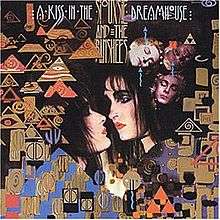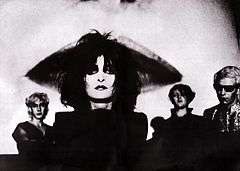A Kiss in the Dreamhouse
| A Kiss in the Dreamhouse | |||||
|---|---|---|---|---|---|
 | |||||
| Studio album by Siouxsie and the Banshees | |||||
| Released | 5 November 1982 | ||||
| Recorded | June-August, 1982 | ||||
| Studio | Playground Studios, Camden Town and Abbey Road Studios, England | ||||
| Genre | Post-punk, neo-psychedelia | ||||
| Length | 37:45 | ||||
| Language | English | ||||
| Label | Polydor | ||||
| Producer | Siouxsie and the Banshees | ||||
| Siouxsie and the Banshees chronology | |||||
| |||||
| Siouxsie Sioux chronology | |||||
|
|||||
| Singles from A Kiss in the Dreamhouse | |||||
A Kiss in the Dreamhouse is the fifth studio album by British rock band Siouxsie and the Banshees. It was released on 5 November 1982 by Polydor Records. The record marked a change of musical direction, as the group used strings for the first time and experimented in the studio. Guitarist John McGeoch played more instruments, including recorder and piano. For Julian Marszalek of The Quietus, the release proved the Banshees to be "one of the great British psychedelic bands" of the post-punk era.[1]
Both a critical and commercial success, A Kiss in the Dreamhouse peaked at No. 11 on the UK Albums Chart.[2] The Banshees themselves claimed it to be their best, until the release of Peepshow in 1988.[3] In August 2007 it was ranked No. 1 on Mojo magazine's list of the best albums of 1982.[4] The album was remastered and reissued in 2009.
Background, production and music
The band held back from writing after the success of 1981's Juju. During the spring of 1982, they went on tour in Scandinavia with three tracks completed: "Cascade", "Painted Bird" and "Green Fingers". When they returned to the studio in July, the group embarked on a week of improvisation sparked off by a tape-looped section of the orchestral version of "Fireworks", a non-album single they had released in May. Other numbers followed easily.[5] Siouxsie didn't want to use synthesizers for the arrangements:

"Fireworks" indicated the direction we wanted for the album. We wanted strings [...] John [McGeoch] wanted a machine but Steve [Severin] and I said it had to be real strings. They give a real, earthy, rich sound. You could hear the strings spitting and breathing and wheezing. Me and Steve have always wanted our music to be performed by the Royal Philharmonic Orchestra. We've always thought our songs would suit orchestration. Real strings have a very physical sound".[6]
A Kiss in the Dreamhouse was the first album on which the Banshees really exploited the possibilities of the studio.[7] They allowed themselves to be inspired by sounds.[7] Engineer Mike Hedges, who was interested in vocals, put different effects on Siouxsie's voice and multi-layered it.[8] Hedges also encouraged them to fiddle with effects; if the band came up with something off-the-wall, he'd want to top it.[9]
According to the band, A Kiss in the Dreamhouse was probably their most experimental work.[9] The album contains recorders, chimes, tubular bells, loops and many vocal overdubs.
The personal dynamics associated with the period in which A Kiss in the Dreamhouse was recorded were often less than healthy. The band's recently-fired manager and Siouxsie's former partner, Nils Stevenson, had become obsessive in response to her developing relationship with Budgie. The band spent long hours in the studio, fuelled by drink and drugs. Guitarist McGeoch became seriously ill due to alcoholism and a mental breakdown, though other band members were unaware of this until the end. Shortly after recording finished, the studio's co-owner died of a heroin overdose. According to Uncut writer Garry Mulholland, the "stunningly beautiful music" of Dreamhouse was "a product of addiction, stress, old, sick love and new, dangerous love, money woes and a darkness that would eventually claim three lives".[10]
Title and artwork

The title of A Kiss in the Dreamhouse came to Severin after watching a programme about Hollywood prostitutes in the 1940s who had cosmetic surgery to look like stars, so they could get more clients.[9] The "Dreamhouse" was a brothel in Los Angeles that actually existed where people could meet perfect replicas of the stars of the time, women like Mae West.[7]
The quote in the inner sleeve, "Nellie the Elephant packed his trunk and said goodbye to the circus", referred to longtime former manager Stevenson (nicknamed "Nellie"), who was fired before the recording of the album.[9]
The album's artwork was inspired by the paintings of Gustav Klimt. As the Banshees achieved the richness they desired, they wanted "a really colourful sleeve with lots of gold and deep colours because we felt the music was very rich".[7]
Critical reception
| Professional ratings | |
|---|---|
| Review scores | |
| Source | Rating |
| AllMusic | |
| Melody Maker | very favourable[12] |
| NME | very favourable[13] |
| The Quietus | very favourable[1] |
The UK music press was unanimous in its praise for the album on its release. NME's Richard Cook considered it innovative:
A Kiss in the Dreamhouse is a feat of imagination scarcely ever recorded. It's breathtaking. Somehow, a bold assurance of intention has met with a hunger for experimenting with sound to expand an already formidable group of songs into pure, open-minded ambiguity. The flesh of the song will balloon out or contort into unimaginable patterns; indecipherable echoes volley between the walls of the recording; glassy, splintered tones pierce the luxuriant sheen of the mix. Repeated listens trick the sense of balance; tremendous risks are taken.[13]
Cook finished his review by saying, "I promise. This music will take your breath away".[13] The album was ranked at No. 11 in the NME top "Albums of the Year" for 1982, with "Slowdive" ranked among the year's top 50 tracks.[14]
Melody Maker's Steve Sutherland also welcomed the new musical direction: "The Banshees achieve an awesome, effective new pop without so much as a theory or qualm. Dreamhouse is an intoxicating achievement".[12] Critic David Cleary of AllMusic would later describe the single "Slowdive" as "a violin-colored dance beat number", with "a catchy melodic hook away from being the real thing", and positively assessed the album, saying, "This fine platter is well worth purchasing".[11]
In their 2009 review of the reissued album, The Quietus wrote: "The result was their most colourful and – ahem – kaleidoscopic collection yet".[1] Critic Julian Marszalek commented that the album's music is "fundamentally pop, yet unafraid to revel in a quirkiness born of altered states. A deliberate shift from the overt darkness of its predecessor, Juju".[1] Marszalek qualified the work of guitarist McGeoch as "a seamless beauty", and wrote that "Siouxsie's voice achieves a sense of strength and maturity".[1] The journalist concluded the review by noting that "Siouxsie and the Banshees weren't afraid to stretch themselves. Here was a band that dared to challenge itself as much as their listeners".[1]
Legacy
Several bands later covered and sampled songs from this album. LCD Soundsystem released a version of "Slowdive" as the B-side to their single "Disco Infiltrator"; it was also included on their Introns compilation in 2006. The Beta Band sampled the live Nocturne version of "Painted Bird" on their track "Liquid Bird", issued on their 2003 album Heroes to Zeros.[15]
Track listing
All lyrics written by Siouxsie Sioux, except where noted; all music composed by Siouxsie and the Banshees (Sioux, Steven Severin, John McGeoch, Budgie).
| No. | Title | Lyrics | Length |
|---|---|---|---|
| 1. | "Cascade" | Severin | 4:25 |
| 2. | "Green Fingers" | 3:33 | |
| 3. | "Obsession" | 3:51 | |
| 4. | "She's a Carnival" | Severin | 3:39 |
| 5. | "Circle" | 5:22 | |
| 6. | "Melt!" | Severin | 3:47 |
| 7. | "Painted Bird" | 4:15 | |
| 8. | "Cocoon" | 4:29 | |
| 9. | "Slowdive" | 4:24 |
| 2009 remastered reissue bonus tracks | |||
|---|---|---|---|
| No. | Title | Lyrics | Length |
| 10. | "Fireworks (12" Version)" | Severin | 4:32 |
| 11. | "Slowdive (12" Version)" | 5:49 | |
| 12. | "Painted Bird (Workhouse Demo)" | 3:49 | |
| 13. | "Cascade (Workhouse Demo)" | Severin | 4:32 |
Personnel
Siouxsie and the Banshees
- Siouxsie Sioux – vocals, bells on "Obsession", production
- Steven Severin – bass guitar, six-string bass guitar on "Slowdive", organ on "Painted Bird", production
- John McGeoch – guitar, keyboards on "Cocoon", "Circle" and "Cascade", recorder on "Green Fingers", production
- Budgie – drums, percussion, harmonica on "Slowdive", production
Additional personnel
- Caroline Lavelle – cello on "Obsession"
- Anne Stephenson – violin on "Obsession" and "Slowdive"
- Virginia Hewes – violin on "Obsession" and "Slowdive"
Production and artwork
- Mike Hedges – engineering
- Rocking Russian – sleeve design
- Michael Kostiff – sleeve photography and set
References
- 1 2 3 4 5 6 Marszalek, Julian (10 April 2009). "Siouxsie & the Banshees reissues A Kiss In The Dreamhouse Nocturne Hyaena Tinderbox". The Quietus. Retrieved 1 September 2012.
- ↑ "Siouxsie & the Banshees [uk charts]". officialcharts.com. Retrieved 29 April 2013.
- ↑ Mathur, Paul (9 July 1988). "Born Again Savages". Melody Maker.
- ↑ "80 From The 80’s". Mojo. August 2007. Retrieved 1 September 2012
- ↑ Steve Sutherland. "Fireworks expected in Siouxsie's Dream House". Melody Maker. 14 August 1982
- ↑ Cooper, Mark (18 December 1982). "Let's Get Physical". Record Mirror.
- 1 2 3 4 Cooper, Mark. "Let's Get Physical". Record Mirror. 18 December 82
- ↑ Paytress, Mark. p.120
- 1 2 3 4 Paytress, Mark. p.124
- ↑ Mulholland, Garry (November 2012). "Siouxsie And The Banshees: "We were losing our minds"". uncut.co.uk. Time Inc. (UK) Ltd.
- 1 2 Cleary, David. "A Kiss in the Dreamhouse – Siouxsie and the Banshees". AllMusic. Retrieved 1 September 2012.
- 1 2 Sutherland, Steve (6 November 1982). "Awakening Dreams [A Kiss in the Dreamhouse - review]". Melody Maker.
- 1 2 3 Cook, Richard (6 November 1982). "A kiss in the Dreamhouse review". NME. Rock's Backpages (subscription required). Retrieved 1 October 2012.
- ↑ "Albums and Tracks of the Year". NME. 2016. Retrieved 6 November 2016.
- ↑ Lapatine, Scott (April 2004). "The Beta Band Interviews and Articles". Earlash. Archived from the original on 16 January 2010. Retrieved 1 September 2012.
EL: On previous albums, you've used some left-field samples as a jumping off point to do something new and original. JM: Yeah, we've got Siouxsie and the Banshees on this record. It was Robin's idea.
- Sources
- Mulholland, Garry. A Kiss in the Dreamhouse, Uncut, November 2012, pp 16–21
- Paytress, Mark. Siouxsie & the Banshees: The Authorised Biography. Sanctuary, 2003. ISBN 1-86074-375-7
